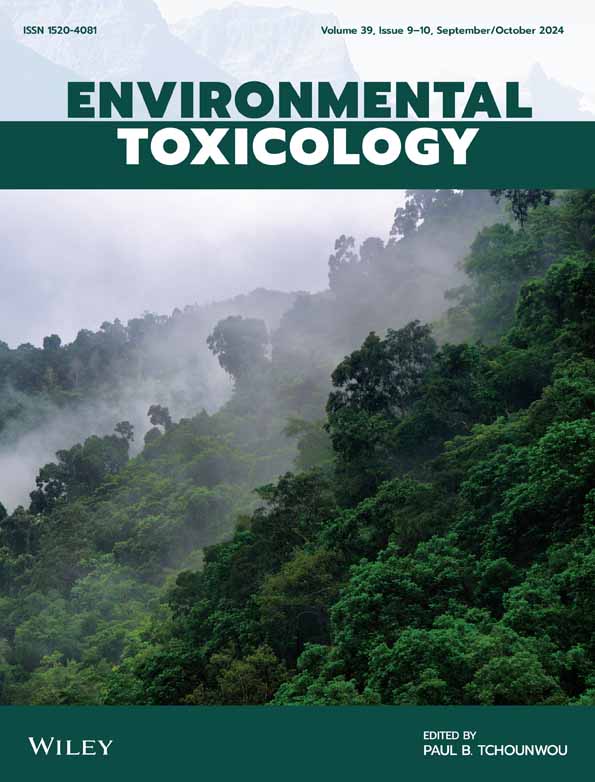氟虫腈对人星形胶质细胞的毒性机制及维生素E对氟虫腈毒性的保护作用。
IF 3.2
3区 医学
Q2 ENVIRONMENTAL SCIENCES
引用次数: 0
摘要
氟虫腈(Fipronil, FIP)是一种广泛使用的农业杀虫剂,由于其有害的环境残留和神经毒性作用而引起了人们的极大关注。虽然FIP的毒理学影响已经在一些神经细胞模型中进行了研究,但其对人类神经胶质细胞的具体影响仍然知之甚少。本研究旨在探讨fip诱导的毒性机制,并评估维生素E (VE)的保护潜力,维生素E是一种已知的抗氧化剂。我们使用人类星形胶质细胞(GHA)细胞,用FIP (5-25 μM)、VE (20 μM)或两者同时处理细胞,并将它们的反应与未处理的对照组进行比较。我们的研究结果表明,FIP显著降低了星形胶质细胞的活力,并引起了细胞萎缩和脱离的形态学改变。FIP还增加了活性氧(ROS)的产生和细胞内谷胱甘肽(GSH)水平的降低,表明细胞氧化还原平衡被破坏和氧化应激的发生。此外,FIP通过上调Bax、caspase-9和caspase-3,并下调抗凋亡蛋白Bcl-2,触发了凋亡通路的激活。同时,FIP通过调节Nrf2/HO-1/NQO1信号通路破坏抗氧化防御机制。有趣的是,VE预处理有效地逆转了这些效应。VE降低ROS水平,补充谷胱甘肽,减轻细胞凋亡,恢复抗氧化蛋白表达,保护星形胶质细胞免受fip诱导的细胞毒性和氧化损伤。这些发现强调氧化应激是fip诱导的星形胶质细胞毒性的关键因素,并将VE作为一种有前途的保护剂。进一步研究VE在减轻环境毒素如FIP引起的氧化应激相关神经毒性方面的治疗潜力是必要的。本文章由计算机程序翻译,如有差异,请以英文原文为准。
Toxic Mechanisms of Fipronil in Human Astrocytes and the Protective Effect of Vitamin E on Fipronil-Induced Toxicity.
Fipronil (FIP), a widely used agricultural insecticide, has raised significant concerns due to its harmful environmental residues and neurotoxic effects. Although FIP's toxicological impact has been studied in some neuronal cell models, its specific effects on human glial cells remain poorly understood. This study sought to investigate the mechanisms of FIP-induced toxicity and evaluate the protective potential of vitamin E (VE), a known antioxidant. Using human astrocyte (GHA) cells, we treated cells with FIP (5-25 μM), VE (20 μM), or both and compared their responses to untreated controls. Our findings revealed that FIP significantly reduced cell viability and caused morphological changes in astrocytes, including cellular shrinkage and detachment. FIP also increased the production of reactive oxygen species (ROS) and depleted intracellular glutathione (GSH) levels, indicating a disruption of cellular redox balance and the onset of oxidative stress. Furthermore, FIP triggered the activation of apoptotic pathways through upregulation of Bax, caspase-9, and caspase-3, coupled with downregulation of the antiapoptotic protein Bcl-2. Concurrently, FIP disrupted antioxidant defense mechanisms by modulating the Nrf2/HO-1/NQO1 signaling pathway. Interestingly, pretreatment with VE effectively reversed these effects. VE reduced ROS levels, replenished GSH, mitigated apoptosis, and restored antioxidant protein expression, protecting astrocytes against FIP-induced cytotoxicity and oxidative damage. These findings highlight oxidative stress as a critical factor in FIP-induced astrocyte toxicity and position VE as a promising protective agent. Further research is essential to explore VE's therapeutic potential in mitigating oxidative stress-related neurotoxicity caused by environmental toxins like FIP.
求助全文
通过发布文献求助,成功后即可免费获取论文全文。
去求助
来源期刊

Environmental Toxicology
环境科学-毒理学
CiteScore
7.10
自引率
8.90%
发文量
261
审稿时长
4.5 months
期刊介绍:
The journal publishes in the areas of toxicity and toxicology of environmental pollutants in air, dust, sediment, soil and water, and natural toxins in the environment.Of particular interest are:
Toxic or biologically disruptive impacts of anthropogenic chemicals such as pharmaceuticals, industrial organics, agricultural chemicals, and by-products such as chlorinated compounds from water disinfection and waste incineration;
Natural toxins and their impacts;
Biotransformation and metabolism of toxigenic compounds, food chains for toxin accumulation or biodegradation;
Assays of toxicity, endocrine disruption, mutagenicity, carcinogenicity, ecosystem impact and health hazard;
Environmental and public health risk assessment, environmental guidelines, environmental policy for toxicants.
 求助内容:
求助内容: 应助结果提醒方式:
应助结果提醒方式:


